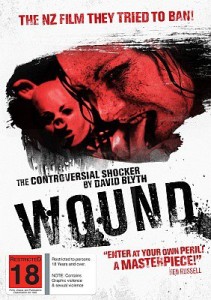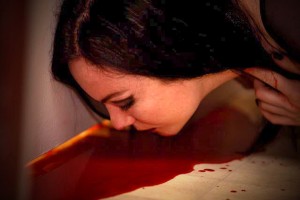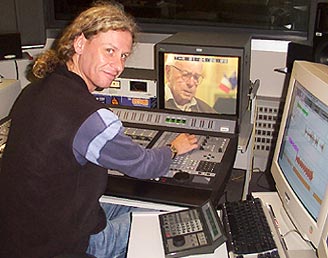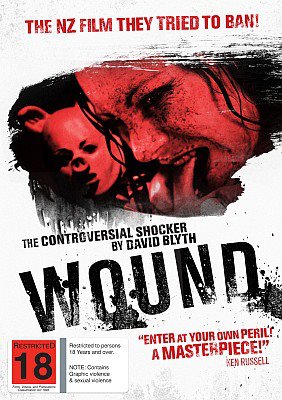Wound is a film I recently reviewed on this site; an independent film from New Zealand that can best be described as psychological surrealist art-horror. It’s a film that leaves the viewer with more questions than answers, and thankfully director David Blyth was happy to answer a few for Ave Noctum.
 AN: Hello and first of all thanks for agreeing to this interview. First of all, how would you personally describe Wound?
AN: Hello and first of all thanks for agreeing to this interview. First of all, how would you personally describe Wound?
DB: “Wound” is a woman’s pictorial descent into madness, seen as a series of events or visual mental shards from Susan’s tragic life as she fights a losing battle for her sanity in an indifferent and uncaring world.
AN: Can you explain what the title ‘Wound’ is all about? At a guess I assume it relates to the main character Susan and her wounded psyche – does it have more than one meaning?
DB: The film title “Wound” does indeed have two interpretations, both are relevant. Firstly as a deep psychic wound that has been inflicted on Susan. Secondly as in wound up, spiral wrapping which references the plastic glad wrap bondage scenes in the film where Susan and Tanya are bound/wound together as one.
AN: Would you say there is any overall message or any kind of social commentary embedded in the film?
DB: “Wound” looks at what happens when you fall under a functioning society’s bottom line, where poverty and mental illness combined with obsession, lead to some extreme outcomes. “Wound’s” opening castration encounter with father and daughter was taken from a Court Report in a US Newspaper. The Judge’s comment, that the accused woman needed counselling, set my mind to thinking about what kind of events lead to this sort of outcome in our new globalized digital society. I’m very interested in the horror found in the everyday events happening around us rather than franchise horror themes.
AN: One thing that very obviously came across to me when watching the film is that a lot of things seem to be very open to interpretation. Just as an example, a fellow writer for AN, who is also a big fan of extreme cinema, watched this film and seemed to experience it in a totally different way than I did. I think a lot of the scenes are very ambiguous and don’t provide you with straight answers. Was this your intention – and exactly how much did you intend the film to rely on personal interpretation?
DB: Yes, the images and story have been constructed in a pictorial way, so as to leave personal visual interpretation open to the individual watcher. This also allows for the watchers own life experience to colour their understanding.
Cinema-goers have become accustomed to being spoon fed a very talky “Hollywood Style” narrative logic, and I wanted to break away from that model and explore in a more unconscious symbolic way, the power of the image to connect with the individual in a deep way.
AN: I was intrigued by the BDSM angle of the film, as to me it comes across as having a stronger emphasis on the psychological side of the lifestyle rather than purely showing it in a sexual light. This strikes me as being very significant in externalising Susan’s internal torment and I see it as very powerful. Was this your intention and do you think the film would have worked as well with a vanilla relationship between the characters?
DB: The BDSM angle is in many ways an extreme magnification of the patriarchal society that we all currently live in. The D/S scenes allowed the mechanics of the psychological thought process to be laid bare. There was a method to the madness, so to speak. Certainly a vanilla relationship would not have allowed the same insights to unfold. The thresholds crossed in “Wound” are very real ones.
AN: You previously filmed a documentary on the BDSM scene in NZ, which made perfect sense given some of the content in Wound. Did your experience working on the documentary and meeting people involved in the scene in some way provide inspiration for the D/s relationship between the main characters?
DB: I made a feature length documentary called “Bound For Pleasure”, an intimate study of six Dominatrix and their dungeon clients. Mistress Sandy featured with her son Master Lance in one of the documentaries segments. I askedSandyto play the dominatrix mother (Mistress Ruth) in “Wound” to add a powerful authenticity to the role and it is another example of crossing between artificiality and reality.
AN: Some of the later scenes involving Susan’s parents particularly highlighted in my mind the theory that trauma can go round in a circle; if you have witnessed/experienced a traumatic/abusive relationship as a child this can be almost subconsciously sought out in adulthood. Am I way off with this interpretation – and can you talk a bit about where the parents fit in terms of the main character Susan’s psyche?
DB: Your interpretation is correct. We are all trapped in family cycles or circles that we unconsciously play out generation after generation. Alejandro Jodorowsky talks about this in his “Psychomagic” teachings. Richard von Sturmer’s poem at the end of the carriage scene in “Wound” sums it up perfectly.
“Her daughter
you caught a glimpse
of her daughter
when she opened the door
half opened the door
and you knew
then and there
that her story
would continue
through her daughter.”
 AN: How important would you regard the gore aspect of Wound? Where it is used it seems to really compliment the nightmarish hallucinations and give a great visual aspect to things.
AN: How important would you regard the gore aspect of Wound? Where it is used it seems to really compliment the nightmarish hallucinations and give a great visual aspect to things.
DB: I use the bloody gore as my psychic heavy artillery to confront the audience with physical bodily disintegration. It also dissolves the line between reality and hallucination and opens the door to contact the unconscious parts of the mind.
AN: On the subject of gore, can you talk a bit about the special effects in the film. How did you achieve some of the effects in the gorier scenes?
DB: “Wound” Co-producer and prosthetic SPFX wizard, Andrew Beattie, was in charge of designing and creating the memorable special effects scenes. Constructing the giant vulva was the most labour intensive prop in the whole shoot. The filming of the birthing scene went surprisingly smoothly, without a hitch, we had two cameras filming and was certainly one of the highlight moments of the whole shoot. Creating a spectacular unique scene that is certainly memorable in “Wound”.
AN: Regarding the scenes of a sadomasochistic nature, how much of this was done for real, and did any of the actors involved have any problems with what was required of them?
DB: The D/s scenes were all done for real, such as the clothes pegs scene. The “sub space” mental state was a deliberate attempt to show a mental process unfolding in a real way.
A number of the actors’ agents, voiced concerns about the Wound script’s content. The actors accepted my lengthy psychological explanation of why I wanted to show these types of scenes as part of Susan’s mental disintegration.
AN: How did you go about choosing the actors for the film, and were there any problems when it came to casting?
DB: The casting for “Wound” happened in a very organic way. I had worked with Te Kaea Beri at a film school previously and had been impressed with her potential. After casting her as Tanya, in “Wound” she suggested I check out her fellow “Meisner” acting class student, Kate O’Rouke. I met with Kate and realized I had found Susan and an actress with the focus and power to take an audience on a rollercoaster ride to hell.
 AN: In retrospect, is there anything about the film that you wish you had done differently, or that you are not happy with?
AN: In retrospect, is there anything about the film that you wish you had done differently, or that you are not happy with?
DB: I’m very happy with the way Wound turned out. I have no regrets; it was a fantastic experience to make and has an intriguing unsolvable mystery at its core, which is what life is all about for me.
AN: There was a bit of an outcry from lobby group “Family First” to ban Wound, which thankfully didn’t lead anywhere. It’s always helpful to have some controversy to help sell your film but at the same time it’s really ridiculous that in this day and age anyone would try to ban a movie. What were your thoughts about this call for censorship – did it make you angry or did you just find it laughable?
DB: The call to ban “Wound” from the “Family Values” group was the best piece of publicity we got for the film, and inNew Zealand, it certainly gave the film some visibility when we had no money to promote the film. It also harks back to the reception my first feature film “Angel Mine” received from the censor (R18: Contains Punk Cult Material) which was more a judgement than a classification. “Angel Mine”, was the very first film funded by the New Zealand Film Commission. It was greeted with, questions in Parliament and howls of protest from film critics and Family Values organizations, one headed by an ex Nun, Patricia Bartlett. So in many ways the reaction to “Wound” was history repeating itself, but this time without government funding. At least in my film making I have been consistent over my 30 year plus career.
AN: I read that you had cut some scenes from the film before releasing it. Can you explain what these were and your reasons for cutting them out?
DB: There were a couple of scenes involving Tanya’s boyfriend that were cut from the final film to focus more on the mother-daughter relationship. Because the film shoot was only 12 days, virtually every other scene is in the film.
AN: NZ has previously been notoriously unsupportive of independent film-makers in the past, for example it was well documented that Peter Jackson had a hard time gaining funding and support early on in his career with films like Meet The Feebles and Bad Taste and only really offered funding to films that were quite safe and likely to be a commercial success. Have you experienced similar problems and has this changed at all in recent years?
DB: “Wound” was a micro budget film which was funded privately by three long time supporters. There is no way that a tax payer funded Film Commission, would have invested in a film like “Wound”. Because the investors believed in my vision there was no compromise of vision or content and the art of cinema is all about singular vision, not a committee generated commercial compromise, this is why I believe “Wound “ is so unique and will stand the test of time.
AN: NZ horror doesn’t seem to get much profile over here, are there any films released recently that you would recommend that may have gone un-noticed to readers in the UK?
DB: New Zealand Horror Films have been very thin on the ground in recent years. “Devil’s Rock” is another recent Kiwi horror that has been released in the UK in the last year. Both “Wound” and “Devils Rock” played at Fright Fest London in the last few years. “Wound” of course is available in the UK on DVD through distributor Cine du Monde.
AN: What really inspires you to make movies, and also are there any directors that have particularly influenced your work?
DB: Cinema is such a powerful medium for taking audiences to new realms and ways of seeing. Luis Bunuel’s film “Discreet Charm of the Bourgeoisie”, which I saw as an impressionable sixteen year old, completely changed my life. Other directors like Jodorowsky, Cocteau, Fellini, Russell and Polanski were also a big influence on my early film making approach.
AN: On a similar note, are there any modern film-makers around who you are particularly impressed by?
DB: American directors such as David Lynch and Tim Burton, Japanese directors like Takashi Miike, Tsukamoto Shinya and Shozin Fukui. French director Gaspar Noe, are directors whose work has been influential in recent years.
AN: The internet obviously has changed the way people interact with film and I think it has both positive and negatives. As a film-maker, what are your thoughts on people streaming/downloading films illegally and do you see it has helped or hindered you in the sales/marketing of Wound?
DB: The Internet and the “Digital Revolution” has changed the way we watch and make films, the old paradigm of film distribution has changed forever, but the film distribution institutions are slow to change.
AN: On a final note, do you have anything in the pipeline that you are working on?
DB: I have been working on several of my own scripts, plus looking around and reading lots of horror scripts in an attempt to find a project that was still unique but more mainstream as a follow up to “Wound”.
David Blyth’s Wound is available to purchase now via Breaking Glass Distribution (US) www.breakingglasspictures.com and Cine Du Monde Distribution (UK) www.cinedumonde.co.uk/

Leave a Reply